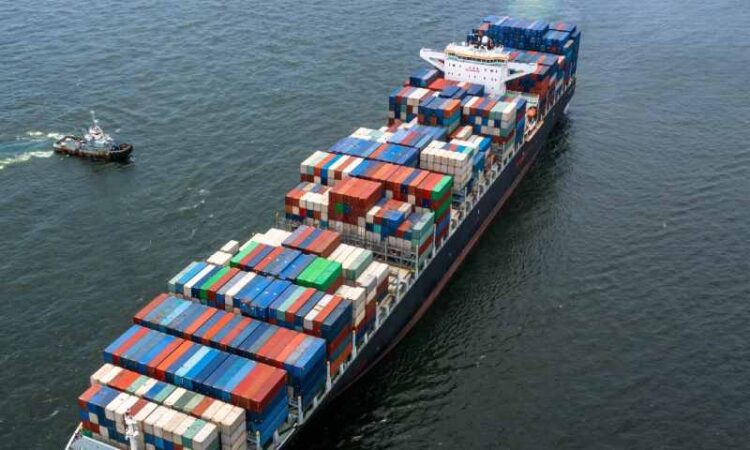
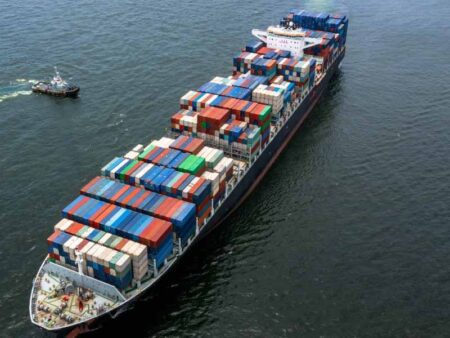
Image credit: PTR Inc.
The European Union has embarked on an inspiring path that advocates for the adoption of shore-to-ship power systems in the maritime sector, writes Hafsa Shafiq of PTR Inc.
In its quest for a more environmentally friendly and sustainable future, the European Union (EU) has taken decisive action to mitigate the negative effects of greenhouse gas emissions. Inspired by the significant Paris Agreement, the EU has set ambitious goals for reducing carbon emissions and has embarked on a transformative journey across different sectors.
The EU actively promotes eco-friendly solutions, from encouraging the use of electric vehicles on land to revolutionising the maritime industry. By prioritising pollution reduction and embracing innovative approaches, the EU has embarked on an inspiring path that advocates for the adoption of shore-to-ship power systems in the maritime sector.
Recognizing the environmental challenges posed by sea vessels during their port stays, the EU acknowledges the harmful effects of traditional diesel generators. To address this problem, the EU has championed the widespread implementation of shore-to-ship power systems, which have revolutionised port operations and ushered in a new era of sustainability.
These state-of-the-art systems allow vessels to seamlessly switch off their diesel generators while docking and instead utilise electricity from the port’s power infrastructure. This innovative approach not only eliminates harmful emissions but also significantly reduces noise and vibrations in port areas, providing tangible benefits to nearby communities and marine ecosystems.
By facilitating the connection of ships to cleaner power sources during their stationary periods, the EU actively mitigates the environmental impact of the maritime industry and transforms ports into thriving centres of sustainability and progress.
Have you read?
Transforming commercial structures into energy-optimising powerhouses
BMW Group to source aluminum produced using hydropower
As we delve deeper into the policy and funding landscape surrounding shore-to-ship power systems in the EU, it becomes increasingly evident that a fundamental shift is underway. This article highlights the strategies of the European Union (EU) aimed at achieving decarbonisation within the maritime industry, primarily through the widespread adoption of onshore power supply (OPS) systems.
Additionally, the article explores the funding mechanisms put in place to facilitate the integration of OPS on a larger scale. A comprehensive examination of shore power policies and initiatives in various countries is provided, with a particular focus on recent advancements in recent years.
Regional Efforts in the Deployment of Shore-to-Ship Power
· The European Green Deal
The European Green Deal presents an opportunity to address climate change and construct a new economic model, with all 27 EU Member States committing to make the continent climate-neutral by 2050 through a minimum 55% reduction in emissions by 2030.
· EU Fit for 55 – Targets & Timeline
The European Union (EU) has established targets through its Climate Law to achieve a minimum reduction of 55% in greenhouse gas (GHG) emissions by 2030, with the ultimate aim of attaining climate neutrality by 2050. Within the maritime sector, approximately 6% to 7% of CO2 emissions are generated during port stays within the European Economic Area.
This necessitates a strong emphasis on promoting sustainability in shipping and ensuring that port services adopt environmentally friendly practices while also providing infrastructure for alternative fuels. Simultaneously, it is crucial for key maritime and inland ports situated along the trans-European transport network (TEN-T) to adapt to their pivotal role as strategic multimodal nodes and centres for clean energy.
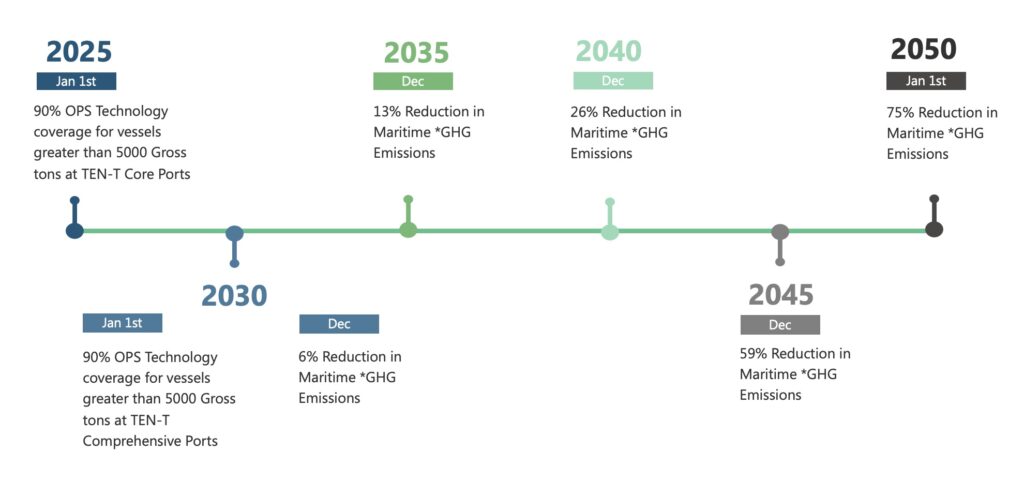
Image: PTR Inc.
· Environmental Port Index
The Environmental Port Index (EPI) acts as a potent reporting mechanism that empowers ship owners and port operators to enhance their sustainability efforts. By evaluating environmental performance and providing valuable operational insights, the EPI enables ships and ports to optimize their operations and minimize their environmental footprint. Through standardized reporting, it facilitates efficient and responsible shipping practices on a global scale.
A ground-breaking collaboration between the Port of Bergen, DNV, and other Norwegian ports has brought about the implementation of the EPI. This innovative reporting tool assesses the operational practices of ships during their mooring periods, focusing on factors such as fuel and energy consumption, with particular attention to emissions like CO₂, NOₓ, and SOₓ. By meticulously analysing and ensuring the quality of the collected data, ships are assigned a score between 0 and 100 based on their environmental performance.
This score serves as the foundation for green incentives at the port, influencing port fees. Ships that achieve high scores benefit from reduced fees, while those with lower scores face additional charges. The successful implementation of the EPI has not only resulted in tangible improvements, such as cruise ships progressively reducing their pollution levels, but it has also inspired the adoption of this tool in seventeen other Norwegian cruise ports.
The Port of Bergen’s success in integrating the EPI showcases their unwavering commitment to fostering sustainable practices and sets the stage for further expansion and global implementation of this influential tool within the maritime industry.
Regional Funding Instruments
European Climate, Infrastructure and Environment Executive Agency (CINEA)
The European Climate, Infrastructure and Environment Executive Agency (CINEA) is responsible for implementing specific EU programs related to climate, infrastructure, and the environment. Its primary role involves executing and managing various initiatives and projects under EU programs to address climate change, develop sustainable infrastructure, and promote environmental protection.
The programs managed by CINEA to facilitate coordination among stakeholders to achieve the objectives set by the European Union in these critical areas include:
- Connection Europe Facility
- Horizon Europe
- Innovation Fund
· CEF Transport Alternative Fuels Infrastructure Facility
Alternative Fuels Infrastructure Facility (AFIF) aims to support the deployment of alternative fuel supply infrastructure for decarbonizing transport along the TEN-T network. With a budget of €1.5 Billion, the AFIF is to be implemented through a rolling call for proposals. The deadline to submit the proposal for the last call is November 07,2023.
· CEF 2 Transport Call
The CEF 2 transport call categorically includes the supply of shoreside electricity in the core and comprehensive ports of the TEN-T network.
· Climate Resilient and Safe Maritime Ports
The EU Horizon Climate Resilient and Safe Maritime Ports initiative seeks to tackle the complex challenges brought about by climate change while simultaneously enhancing the resilience and safety of maritime ports across Europe. This initiative encompasses various projects that are anticipated to yield several significant outcomes. These include bolstering the resilience of port infrastructure, as well as the interconnected inland waterways and land infrastructure.
Additionally, the initiative aims to promote a modal shift towards transportation systems that produce zero or low emissions, ensuring that port access and operations are conducted in a safe manner. Furthermore, efforts will be made to minimize the environmental impact of port activities, while also providing comprehensive guidelines for effectively addressing climate-related risks within the maritime port context.
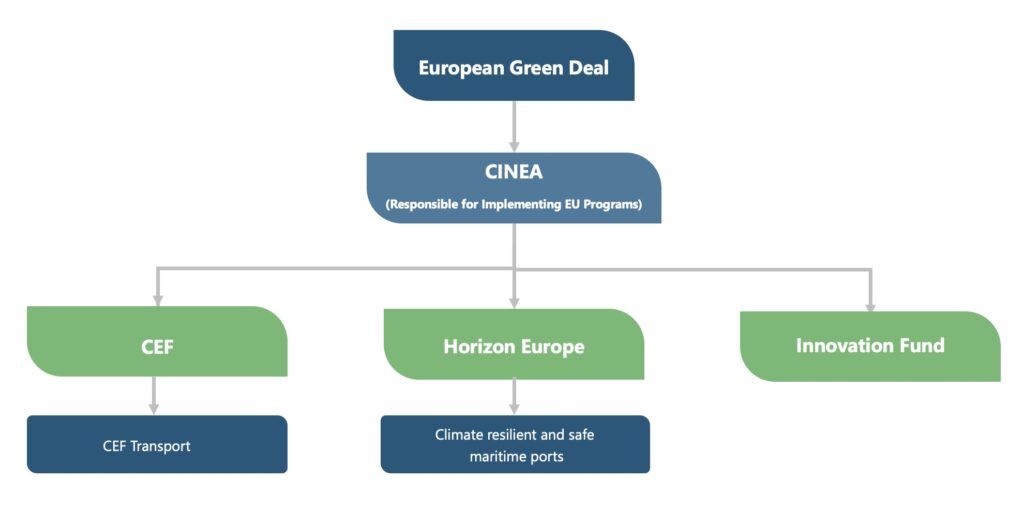
Image: PTR Inc.
Thriving Shore-to-Ship Power Markets
Norway, The Netherlands and Italy are examples of thriving shore-to-ship power markets:
Norway
National Level Policies and Funding Programs
· Green Shipping Program
In 2019, the Norwegian government initiated the Green Shipping Program, a visionary endeavor that places significant emphasis on the crucial role of shore-to-ship power as a means to accomplish emission reduction objectives. This program is dedicated to fostering the advancement and adoption of sustainable maritime solutions, with a particular focus on the development and implementation of shore power infrastructure. By prioritizing this innovative technology, the program aims to contribute to a greener and more environmentally conscious future for the shipping industry.
· Enova SF
Enova SF, a state-owned enterprise, plays a pivotal role in Norway by providing invaluable financial assistance for energy and climate-related initiatives. With a strong commitment to promoting sustainable technologies, Enova offers comprehensive funding programs that encourage the implementation of innovative solutions, including the establishment of shore-to-ship power infrastructure within ports across the country. Since 2016, Enova has been instrumental in supporting over 110 notable shore power projects in Norway, with an impressive cumulative investment of around NOK 850 Million. Through their strategic financial support, Enova has significantly contributed to the advancement of sustainable practices and the realization of a greener future for the maritime industry in Norway.
· NOx Fund
The NOx Fund, established in 2008, is a financial instrument that aims to reduce nitrogen oxide (NOx) emissions in Norway. The fund provides financial support for various measures, including the installation of shore-to-ship power infrastructure, to help vessels reduce their emissions while berthed in ports.
The Role of Stakeholders
As highlighted earlier, the successful promotion of alternative fuel options and the integration of shore-to-ship power in the maritime sector greatly rely on effective collaboration among various stakeholders. Norway serves as a remarkable example of such collaboration through the establishment of Plug, a strategic partnership between the renowned Port of Bergen and BKK, a leading Norwegian company specializing in the generation, sale, and transportation of electrical power.
Plug represents a Norwegian enterprise that specializes in the development and implementation of shore-to-ship power infrastructure. Its primary objective is to facilitate a seamless transition for vessels, enabling them to shift from utilising onboard engines to connecting with onshore power grids during their berthed periods in ports.
By providing the essential infrastructure and services, Plug empowers vessels to access clean and sustainable power sources, leading to a significant reduction in emissions and environmental impact. The collaboration between the Port of Bergen and BKK in the creation of Plug serves as a testament to their shared dedication to fostering sustainable practices within the maritime industry.
Installed OPS Systems in Norway
These charts below showcase the top 5 ports in Norway, highlighting their installed base and capacity split in the realm of shore power infrastructure.
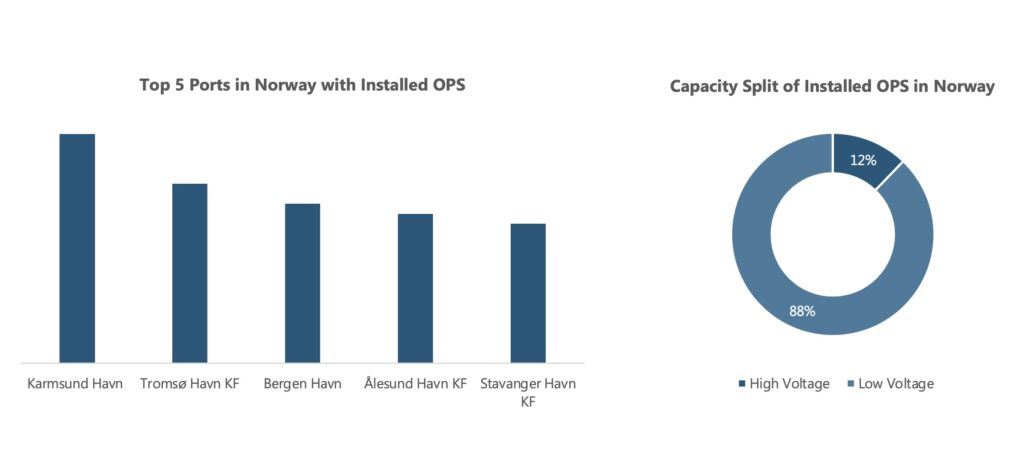
Image: PTR Inc.
The Netherlands
National Level Policies and Funding Programs
· National Air Quality Cooperation Program
The objective of the National Air Quality Cooperation Programme (NSL) is to guarantee compliance with the European limit values for air quality. The NSL fosters collaboration among all levels of government to enhance air quality standards. This program will persist until the Environment and Planning Act is fully implemented.
· Environmental Management Act
The Environmental Management Act in the Netherlands serves as the comprehensive legislation that encompasses almost all national environmental regulations. It establishes an integrated approach to environmental management and defines the roles of national, provincial, and municipal governments. The Act provides various tools for effective environmental management, including environmental plans, environmental quality criteria, environmental impact assessments for major infrastructure projects, the All-in-one Permit for Physical Aspects, environmental permits for large companies, environmental reporting obligations, and enforcement mechanisms carried out by authorities such as the Human Environment and Transport Inspectorate, municipalities, police, and the justice system.
· Netherlands Regulatory Framework – Maritime
· Port-Specific Regulations
The Port of Rotterdam and the Municipality of Rotterdam have partnered to implement shore-based power for sea-going vessels, aiming for a significant share of ships to connect to clean power sources while berthed by 2030. This joint initiative seeks to reduce emissions, improve air quality, and contribute to the sustainability goals of the port, benefiting local residents and the environment.
The port of Amsterdam’s target for sea zero emission vessels powered by zero-emission fuels into operation by 2030 towards full decarbonization by 2050.
· Dutch Ministry of Infrastructure funds for Shore power
The Dutch Ministry of Infrastructure has allocated EUR 140 Million, along with an additional EUR 40 Million from the climate fund, to support the implementation of shore power installations in seaports. In collaboration with the Ministry of Infrastructure and Water Management and the terminals, the five prominent Dutch seaports of Rotterdam, Amsterdam, Groningen, Moerdijk, and North Sea Port are actively pursuing the implementation of shore power solutions within their respective port areas.
Installed OPS Systems in the Netherlands
The following figure displays the top 5 ports in the Netherlands, illustrating their installed base and capacity in terms of shore power infrastructure.
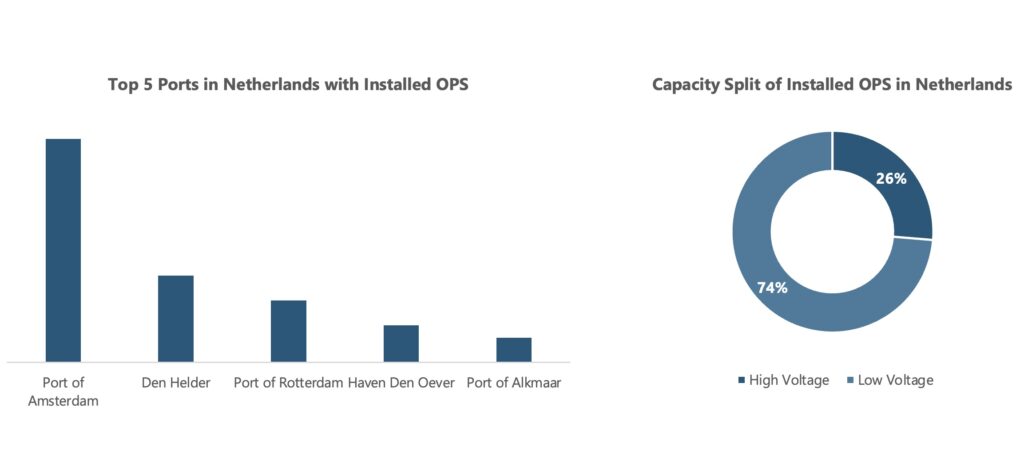
Image: PTR Inc.
Italy
National Level Policies and Funding Programs
· National Recovery and Resilience Plan
Italia Domani, a significant component of Italy’s National Recovery and Resilience Plan (NRRP), represents the country’s contribution to the Next Generation EU initiative, an extensive economic recovery program designed for member states of the European Union. Within the framework of the NRRP, Italy has committed a substantial investment of €191.5 Billion, targeting diverse sectors. Notably, a significant portion of this allocation, totalling €700 Million, is specifically dedicated to the electrification of docks, with the aim of establishing shore-to-ship power connections. This strategic investment underscores Italy’s firm commitment to fostering sustainable practices within the maritime industry and aligns with the nation’s broader vision of advancing green initiatives as part of its recovery and resilience plan.
· State Aid: Commission Approves €500 Million Italian Scheme to Improve the Environmental Performance of Vessels.
In an attempt to achieve the goals of the European Green Deal and EU Fit for 55, the Italian government is supporting the vessel operators for the adoption of shore power connections. The primary objective of this scheme is to incentivize shipping companies to replace vessels with low environmental performance and reduce the usage of fossil-based fuels within the maritime transport sector. The scheme will provide support for projects that enhance the environmental performance and energy efficiency of various types of vessels operating in long-haul, medium-haul, and short-haul services for passenger, freight, and combined transport, as well as vessels operating within Italian ports.
One significant aspect of this scheme is that it will provide aid for the acquisition of clean and zero-emission vessels, including those powered by electricity and hydrogen. Furthermore, it will facilitate retrofitting projects that enable vessels to embrace more environmentally friendly practices. Retrofitting initiatives will focus on enabling vessels to use biofuels and synthetic fuels, such as renewable liquid and gaseous transport fuels of non-biological origin, as alternatives or supplements to traditional fossil fuels. Additionally, the scheme supports the utilization of wind propulsion systems as an alternative to other conventional propulsion methods. It encompasses a wide range of technologies, including battery and fuel cell installations, as well as wind propulsion systems.
Roundup of EU’s Recent Industry Activities: A Snapshot (2019-2022)
The following infographic captures a glimpse of the dynamic and evolving landscape of shore-to-ship power initiatives. This concise yet comprehensive overview encapsulates a myriad of recent endeavours encompassing policy advancements, funding initiatives, collaborative undertakings, and technological innovations.
These collective activities serve as a testament to the proactive measures undertaken by European nations to foster sustainable practices within the maritime sector. Driven by a resolute commitment to reducing emissions and bolstering environmental responsibility, these countries have shown unwavering dedication to constructing a future for the industry that is founded on ecological consciousness and sustainability.
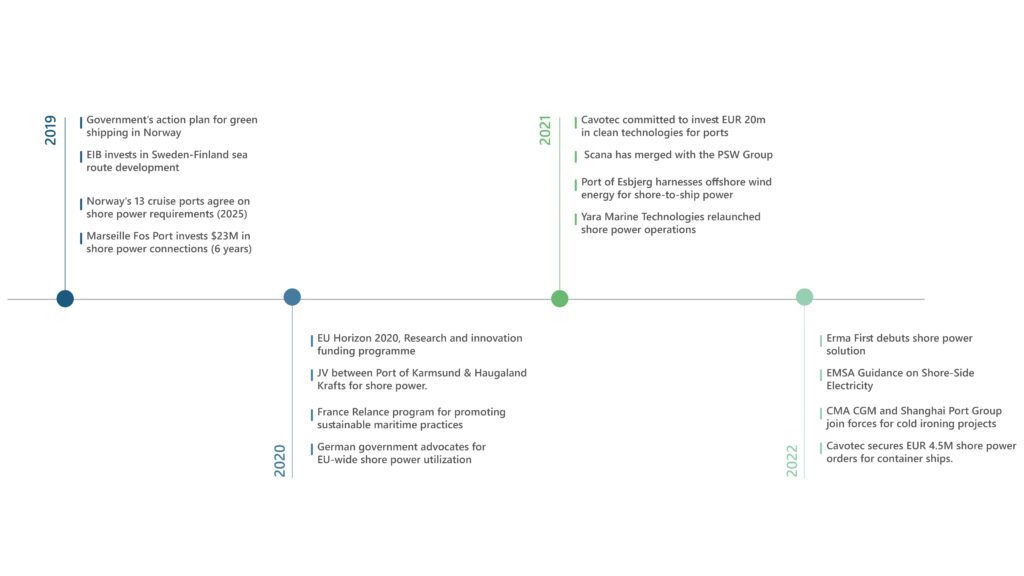
Source: PTR Inc.
Installed OPS Systems in Italy
The leading ports in Italy with our insightful charts showcasing their installed base and capacity for shore power infrastructure.
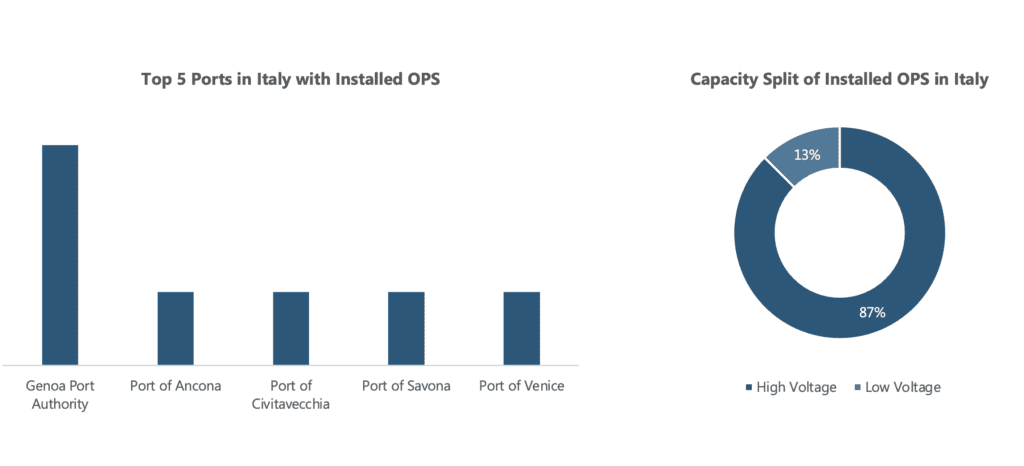
Source: PTR Inc.
Looking Forward
The European Union’s forward-thinking approach effectively harmonizes environmental aspirations with practical measures, propelling a remarkable transformation within ports, ships, and the entire maritime industry toward a greener and more sustainable future. Through collaborative endeavours, well-structured funding programs, and well-informed policies, the EU has expedited the widespread implementation of shore-to-ship power systems infrastructure and the adoption of eco-conscious practices.
Remarkably, the EU’s commitment extends beyond the realm of shore-to-ship power systems, as it actively advocates for the integration of vessel charging systems, thereby paving the way for the electrification of ships themselves.
As the energy demands of the maritime sector continue to escalate, there is a growing emphasis on exploring and developing supporting technologies such as hydrogen and energy storage. These cutting-edge technologies hold immense promise in meeting the surging energy needs of the industry while concurrently mitigating environmental impacts.
Intensive efforts are underway to advance hydrogen technologies, enhance energy storage systems, integrate renewable energy sources, optimize energy efficiency, and foster collaborations that drive the widespread adoption of clean and sustainable energy solutions within the maritime domain. Through these collective endeavours, a more resilient and ecologically friendly future is being forged for the maritime industry, ensuring its long-term sustainability and environmental stewardship.
About the author

Hafsa Shafiq is a Market Analyst at PTR Inc. with expertise in shore-to-ship power technology. She maintains a comprehensive database of installed and planned onshore power supply (OPS) projects across the globe and is developing a TAM model to forecast annual capacity additions in the shore-to-ship market. With a strong research background and a conference publication on sampled data robust control, Hafsa possesses dual qualifications in management and technical fields, with an MBA and MS degree from NUST along with a BS in Electrical Engineering from PIEAS.






